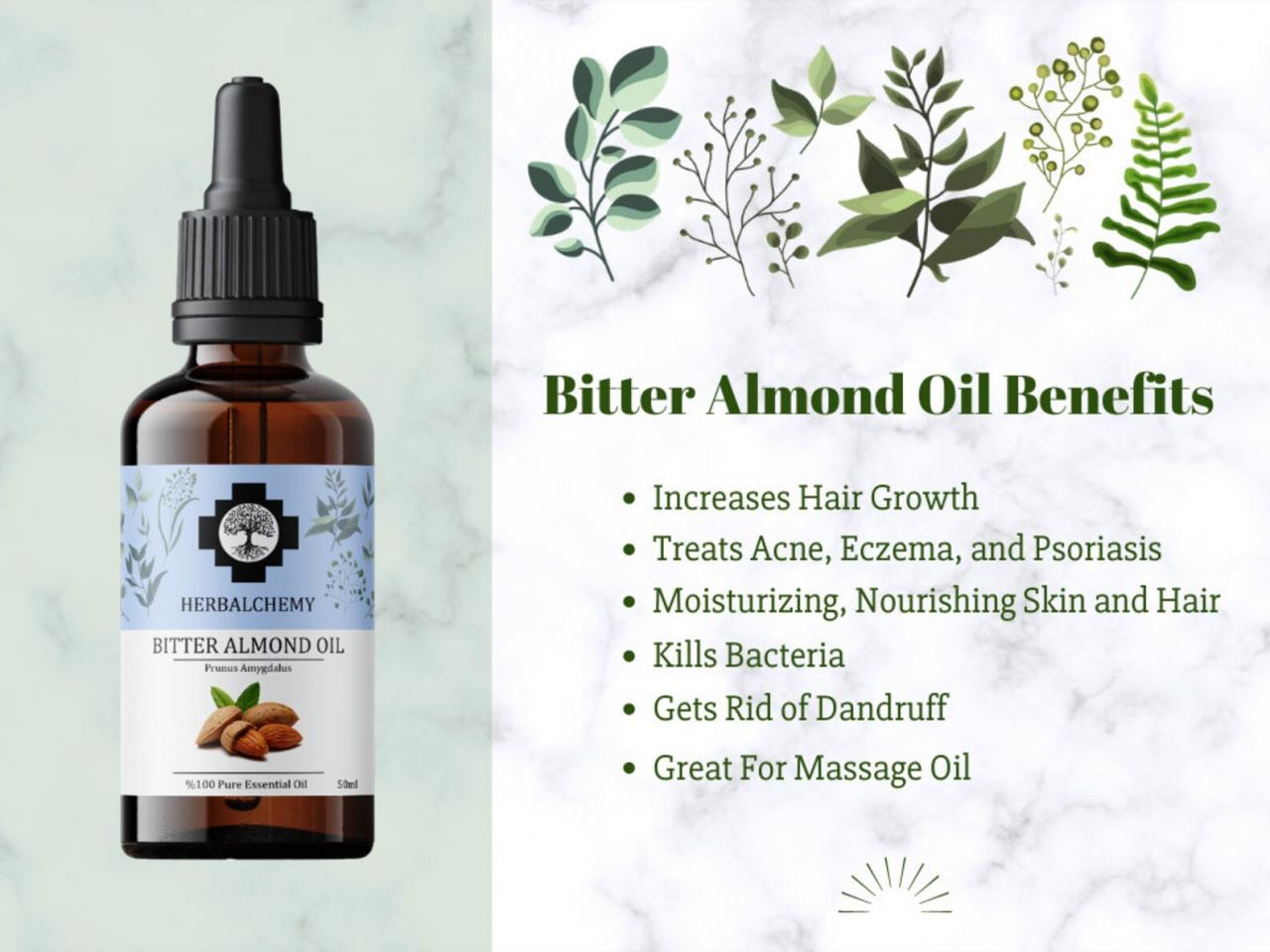Bitter almond essential oil, an aromatic and versatile extract, has captured the attention of both traditional healers and modern scientists. With its distinct chemical profile and therapeutic properties, this oil has carved a niche in the world of natural remedies and industrial applications.
Embark on a journey to discover the captivating essence of bitter almond essential oil, its medicinal wonders, and its historical significance.
Delve into the intricate chemical composition of bitter almond essential oil, where each component plays a crucial role in its therapeutic potential. Explore the various extraction methods employed to harness the oil’s essence, each with its own advantages and drawbacks.
Discover the medicinal uses of bitter almond essential oil, both traditional and modern, supported by evidence-based research. Learn about the safety considerations associated with its use, ensuring responsible and effective application.
Chemical Composition

Bitter almond essential oil, extracted from the kernels of bitter almonds (Prunus amygdalus var. amara), is renowned for its complex chemical composition. This oil is primarily composed of benzaldehyde, a volatile compound responsible for its characteristic almond-like aroma. Other significant components include:
- Benzaldehyde:This compound comprises approximately 90% of the essential oil and contributes to its characteristic odor. It exhibits antimicrobial, antifungal, and insecticidal properties.
- Hydrocyanic acid (HCN):This toxic substance is present in trace amounts in bitter almond essential oil. It can be harmful if ingested in large quantities and should be handled with caution.
- Amygdalin:A cyanogenic glycoside, amygdalin breaks down into benzaldehyde and HCN upon hydrolysis. It is responsible for the bitter taste of bitter almonds.
- Fixed oils:These oils, such as oleic acid and linoleic acid, contribute to the emollient and moisturizing properties of the essential oil.
- Other volatile compounds:Trace amounts of various other volatile compounds, including linalool, limonene, and geranial, contribute to the oil’s overall aroma and therapeutic effects.
It is crucial to note that bitter almond essential oil should be used with caution due to its potential toxicity. The presence of HCN can pose a health risk if the oil is ingested or applied topically in high concentrations.
Therefore, it is essential to dilute the oil properly before use and avoid excessive or prolonged exposure.
Extraction Methods: Bitter Almond Essential Oil

Bitter almond essential oil is extracted from the kernels of bitter almonds through various methods. Each method offers unique advantages and disadvantages, influencing the oil’s yield, quality, and cost.
Cold Pressing
Cold pressing is a traditional method that involves crushing the almond kernels under high pressure without applying heat. This gentle process preserves the delicate volatile compounds and nutrients in the oil, resulting in a high-quality extract with a rich aroma and flavor.
Advantages:
- Preserves the oil’s natural components
- Produces a high-quality oil with a distinct flavor profile
Disadvantages:
- Low yield compared to other methods
- Requires specialized equipment
Steam Distillation
Steam distillation involves passing steam through the crushed almond kernels. The steam carries the volatile compounds from the kernels into a condenser, where they are separated and collected as essential oil. This method produces a higher yield than cold pressing, but the oil may have a slightly less intense aroma and flavor due to the heat involved.
Advantages:
- Higher yield compared to cold pressing
- Suitable for large-scale production
Disadvantages:
- Heat can alter the oil’s composition
- May result in a less intense aroma and flavor
Solvent Extraction
Solvent extraction utilizes a solvent, such as hexane or ethanol, to dissolve the essential oil from the almond kernels. The solvent is then evaporated, leaving behind the concentrated oil. This method offers a high yield and is cost-effective, but the oil may contain traces of the solvent and have a slightly different aroma profile compared to oils extracted by other methods.
Advantages:
- High yield
- Cost-effective
Disadvantages:
- May contain traces of solvent
- Can alter the oil’s aroma profile
Medicinal Uses
Bitter almond essential oil has been traditionally used in various cultures for its therapeutic properties. Modern research has corroborated some of these traditional uses and identified new applications for this essential oil.
Traditional Uses
Traditionally, bitter almond essential oil has been employed for its sedative, analgesic, and expectorant effects. It was commonly used to relieve pain, reduce inflammation, and alleviate respiratory ailments such as coughs and congestion.
Modern Research
Evidence-based research supports the effectiveness of bitter almond essential oil in several therapeutic applications:
-
-*Analgesic
Studies have demonstrated the pain-relieving properties of bitter almond essential oil. It has been shown to reduce pain intensity and inflammation in conditions such as arthritis and muscle pain.
-*Sedative
Bitter almond essential oil exhibits sedative effects, promoting relaxation and sleep. It is commonly used in aromatherapy to reduce stress and anxiety.
-*Expectorant
Bitter almond essential oil helps clear mucus from the respiratory tract, making it beneficial for conditions such as bronchitis and asthma.
-*Antioxidant
Bitter almond essential oil contains antioxidants that protect cells from damage caused by free radicals. This property contributes to its potential role in reducing the risk of chronic diseases.
-*Antimicrobial
Studies have shown that bitter almond essential oil has antimicrobial activity against certain bacteria and fungi. This property makes it a potential natural disinfectant and antiseptic.
Safety Considerations
The use of bitter almond essential oil carries certain risks and contraindications that must be considered to ensure safe usage. Understanding these potential hazards and following proper guidelines is crucial for responsible application.
Due to its high concentration of benzaldehyde, bitter almond essential oil can be toxic if ingested undiluted or in excessive amounts. Ingestion can lead to symptoms such as nausea, vomiting, dizziness, and difficulty breathing.
Contraindications
- Pregnancy and Breastfeeding:Avoid using bitter almond essential oil during pregnancy or breastfeeding as it can cross the placenta and enter breast milk, potentially harming the developing fetus or infant.
- Children:Bitter almond essential oil should not be used on children under the age of 6 as their immature systems are more susceptible to its toxic effects.
- Sensitive Skin:Individuals with sensitive skin may experience irritation or allergic reactions when using bitter almond essential oil. It is recommended to perform a patch test on a small area of skin before applying it to larger areas.
- Medical Conditions:Consult a healthcare professional before using bitter almond essential oil if you have any underlying medical conditions, especially respiratory or cardiovascular issues.
Safe Usage Guidelines
To ensure safe usage of bitter almond essential oil, follow these guidelines:
- Dilution:Always dilute bitter almond essential oil in a carrier oil, such as jojoba or almond oil, before applying it to the skin. A safe dilution ratio is 1-2 drops of essential oil per 10 ml of carrier oil.
- Inhalation:Inhale bitter almond essential oil in small amounts using a diffuser or by adding a few drops to a warm bath. Avoid prolonged or direct inhalation.
- Storage:Store bitter almond essential oil in a cool, dark place away from children and pets. Keep the bottle tightly sealed to prevent evaporation.
Industrial Applications
Bitter almond essential oil finds diverse applications in various industries, including cosmetics, perfumery, and food flavoring. Its distinct aroma and flavor profile make it a popular choice for these sectors.
In cosmetics, bitter almond essential oil is valued for its moisturizing and nourishing properties. It is often incorporated into skincare products, such as lotions, creams, and soaps, to soothe and soften the skin. Additionally, its antiseptic and antibacterial qualities make it beneficial for treating skin conditions like acne and eczema.
Perfumery
The unique fragrance of bitter almond essential oil has made it a sought-after ingredient in perfumery. It is commonly used as a top note in floral and oriental fragrances, adding a sweet and slightly spicy aroma to the composition. The oil’s fixative properties help to enhance the longevity of perfumes, ensuring a lasting scent.
Food Flavoring
Bitter almond essential oil is also employed as a flavoring agent in the food industry. Its distinctive flavor profile complements a wide range of culinary creations, including baked goods, desserts, and beverages. However, due to its potential toxicity, it is crucial to use it sparingly and in accordance with established safety guidelines.
Historical Significance
Bitter almond essential oil has a rich and diverse history, with evidence of its use dating back to ancient times. Its unique aroma and therapeutic properties have made it a valued ingredient in traditional medicine, religious practices, and cultural traditions across various cultures.
Ancient Egypt, Bitter almond essential oil
- Used in embalming rituals to preserve bodies.
- Incorporated into cosmetics and perfumes for their alluring scent.
- Employed as a natural remedy for digestive ailments and skin conditions.
Ancient Greece and Rome
- Hippocrates, the father of medicine, recommended bitter almond oil for treating respiratory issues.
- Used as an expectorant and cough suppressant.
- Incorporated into aphrodisiacs and love potions.
Medieval Europe
- Prized for its medicinal properties, including its ability to relieve pain and inflammation.
- Used in traditional remedies for headaches, earaches, and toothaches.
- Incorporated into religious ceremonies and rituals.
Modern Times
Bitter almond essential oil continues to be used in traditional medicine and aromatherapy for its therapeutic benefits. It is also employed in the production of perfumes, cosmetics, and flavorings.
Summary

In conclusion, bitter almond essential oil stands as a testament to the power of nature’s healing properties. Its rich chemical composition, diverse medicinal uses, and historical significance make it a valuable addition to any holistic health or beauty regimen. As we continue to unravel the secrets of this remarkable oil, its potential to enhance our well-being and enrich our lives remains boundless.
FAQ Section
What are the potential risks of using bitter almond essential oil?
Bitter almond essential oil contains benzaldehyde, a compound that can be toxic in high doses. It is important to use the oil in moderation and to avoid ingesting it. Pregnant and breastfeeding women should not use bitter almond essential oil.
How should I store bitter almond essential oil?
Bitter almond essential oil should be stored in a cool, dark place in a tightly sealed container. It is important to keep the oil away from children and pets.
Can I use bitter almond essential oil in my diffuser?
Yes, you can use bitter almond essential oil in a diffuser. However, it is important to use the oil in moderation and to avoid diffusing it for long periods of time.


